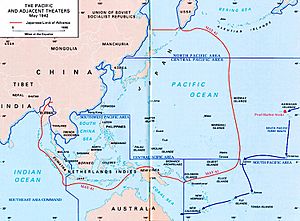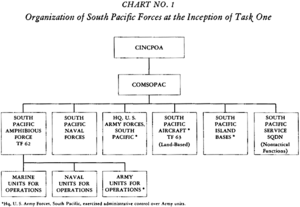South Pacific Area facts for kids
The South Pacific Area (SOPAC) was an important military group during World War II. It was led by the United States and included forces from several countries. SOPAC was part of the larger Pacific Ocean Areas command, which was led by Admiral Chester Nimitz.
This area was created in March and April 1942. Leaders from the United States, the United Kingdom, Australia, New Zealand, and the Kingdom of the Netherlands worked together to set it up. They did this because Japan had attacked many places in Southeast Asia and the Pacific.
The South Pacific Area covered a large part of the Pacific Ocean. It included islands like the Ellice, Phoenix, Marquesas, Tuamotu, Samoa, Fiji, and New Hebrides groups. It also included New Caledonia and New Zealand. Its western border was moved in August 1942 to help with operations around Guadalcanal.
Contents
What Was the South Pacific Area?
The South Pacific Area was a special military command. A "command" is like a big team of soldiers, sailors, and airmen working together. It was set up to fight against Japan in the Pacific Ocean.
Admiral Chester Nimitz was the top leader for all Pacific Ocean Areas. Under him, a U.S. Naval officer was chosen to lead the South Pacific Area. This officer was called the "Commander, South Pacific Area."
The forces in SOPAC included:
- All ground, naval, and air forces assigned to the area.
- Naval forces from New Zealand, Free France, and the Netherlands.
- Other ships and aircraft sent by Admiral Nimitz.
New Zealand's military leaders were in charge of defending their own land. However, they also followed the main plans set by Admiral Nimitz for the Pacific.
Leaders and Teams
In July 1942, Admiral Robert L. Ghormley was the first main leader of the South Pacific Area. Later, Admiral William Halsey Jr. took over on October 16.
Under the main commander, there were several important teams:
- Amphibious Forces, South Pacific: Led by Admiral Richmond K. Turner. These forces were trained for "amphibious operations," which means landing troops from ships onto enemy shores.
- South Pacific Naval Forces: Also led by Admiral Ghormley at first. This team included all the navy ships.
- U.S. Army Forces South Pacific: Led by Major General Millard Harmon. This team included all the army soldiers.
- South Pacific Air Forces: Led by Admiral John S. McCain, Sr.. This team included all the aircraft.
Later, a "Transport Group" was added. This group helped move supplies and troops.
First Big Battle: Guadalcanal
The first major battle for the South Pacific Area was the Battle of Guadalcanal. This was a very important fight. Admiral Ghormley created two special groups, called "task forces," to carry out this operation.
A "task force" is a temporary group of ships, aircraft, and troops put together for a specific mission. These task forces were Task Force 61 and Task Force 63.
Air Power in the South Pacific
On September 20, 1942, Vice Admiral Aubrey Fitch became the commander of Aircraft, South Pacific Force (AirSoPac). This was about six weeks after the first American landing at Guadalcanal.
Admiral Fitch was very active. He often flew into combat zones himself to check on air activities and bases. For his bravery, he received a Distinguished Flying Cross.
AirSoPac included planes from the United States Navy, Army, Marine Corps, and the Royal New Zealand Air Force. These air forces worked together very well. They played a big part in helping the Allies win battles in the area.
AirSols: Directing Combat Flights
Commander, Aircraft, Solomons (ComAirSols) was a special group. It directed all land-based air forces in the Solomon Islands during Operation Cartwheel. This group worked under the direction of AirSoPac.
Rear Admiral Charles P. Mason was the first to lead ComAirSols. He took command on February 15, 1943, at Guadalcanal. Before him, Brigadier General Francis P. Mulcahy had been in charge of all aircraft on the island during the final defense of Guadalcanal. General Mulcahy then became Admiral Mason's chief of staff. This shows how different parts of the military (Navy, Army, Marines) worked closely together in AirSols.
Transporting Supplies and Troops
Vice Admiral Fitch also directly controlled two other flight operations:
- Sea Search: Long-range Navy patrol planes and Army bombers searched the seas.
- Transport Operations: The South Pacific Combat Air Transport Command (SCAT) handled transport flights.
SCAT was very important for moving supplies and troops. It operated from November 1942 to February 1945. SCAT's operations moved northward as the fighting moved. By August 1943, the Naval Air Transport Service (NATS) handled all regular flights in the rear areas of the South Pacific.
Commanders of the South Pacific Area
Here are the main commanders who led the South Pacific Area during World War II:
- Vice Admiral Robert L. Ghormley (May 17 – October 18, 1942)
- Vice Admiral / Admiral William Halsey, Jr. (October 18, 1942 – June 15, 1944)
- Vice Admiral John H. Newton (June 15, 1944 – March 13, 1945)
- Vice Admiral William L. Calhoun (March 13 – September 2, 1945)
See also
- United States Army Air Forces in the South Pacific Area



